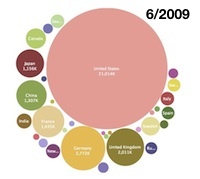John Leidel covered the movement in the Top500 earlier today when the new list was announced during ISC’10. In keeping with previous list announcements, I wanted to take another quick visual look at the world in HPC, and see if there is anything beyond the headlining move by China into the number two slot (by peak GFs) in the world.
Of course, always something to keep in mind is the fact that these are just the machines that these countries talk about. I suspect that at least the major world powers have some pretty fantastic machines buried in secret places.
Here are the bubble charts (click for larger images) from the current and past two lists showing the distribution of Rpeak GFLOPS by country (you can interact with the visualizations in realtime at the ManyEyes site). While the world’s FLOPS are still highly concentrated in just a few countries, nearly all of which are north of the equator (New Zealand, Australia, and South Africa being notable exceptions), the move by China is noticeable, even at a glance.
What does it mean to hold the top slot?
China now has the number two system in the world, and it is the result of a capability build that is several years old now. A number one system is not out of the question for them — they certainly have the resources and the expertise. The last time the US lost the lead on the Top500 list (to Japan’s Earth Simulator) it created an existential crisis in this country. And we are a lot friendlier with Japan than China.
What does it mean to hold the top slot? In terms of scientific advantage, I’d argue that it doesn’t mean much unless the number 1 is orders of magnitude larger than the top 2. A PFLOPS here or there in one machine isn’t going to allow one country to push fundamental borders in innovation or science significantly beyond competitors that have many other slots on the list. If you are using the Top500 as an indicator of science and engineering competitiveness, I think it is much more meaningful to have a very large capability distributed across many systems in a country that is committed to HPC as a pillar of scientific and engineering discovery, than it it to have a handful of systems without a culture of computation. Even if one of those systems is the number one.
But that’s just me. What do you think?







[…] twice before, and now China, occasionally might reach up and grab one of the top spots, as the visualization in this article shows the US has two advantages: nearly all of the world’s largest machines, and far more HPC […]